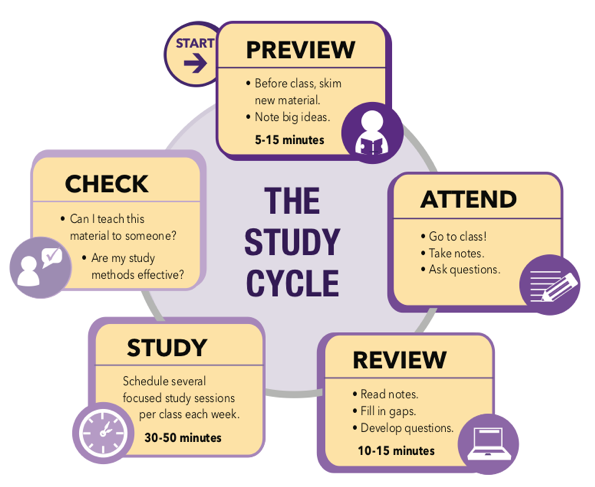
Many students begin to question the effectiveness and efficiency of their study practices, especially as they transition from high school to college, or when they experience a change in the course delivery method like moving from face-to-face to online courses. Feelings of not knowing where or how to begin studying for that next exam, or how to most effectively use the time you have to study, are very common.
What you need to overcome these feelings is a comprehensive framework that will guide you through the learning process. This framework for building effective and efficient study practices can be found in the 5 steps of The Study Cycle – preview, attend, review, study, and check (Figure 1).

Figure 1. The Study Cycle, a model for optimal college studying. Adapted from Frank Christ’s PLRS system (copyright Louisiana State University, Center for Academic Success).
Activity: Checkout this helpful video from the LSU Center for Academic Success for an overview of how to put the 5 steps of the Study Cycle into practice.
Next, let’s take an in-depth look at the fourth step in the Study Cycle – Study. It is important to make sure that studying for that big exam doesn’t start just a few days before the exam. Instead, students should schedule several focused study sessions for each class throughout each week. This spaces out the studying needed for each course, allowing your brain to learn the material step-by-step over time, rather than trying to learn it all at once during a cramming session right before the exam. What you do during these study sessions matters a lot. The 5 elements of a focused study session – plan, study, break, recap, choose – are detailed in Figure 2.

Figure 2. Focused study sessions are designed to work with the way your brain learns best, in short, focused sessions.
Activity: Here’s another video from the LSU Center for Academic Success on how to put together focused study sessions that help you accomplish your learning goals.
Next steps:
- The key is to start applying the Study Cycle to all your courses. But for starters, pick out one class and begin to apply the 5 steps. Be sure to pick one of your more challenging courses.
- Take a quick inventory of your study habits. Ask yourself what steps of the Study Cycle are you already doing well and what steps you need to work on. Make the needed adjustments and continue checking on your progress.
- Print this Study Cycle Handout and keep it nearby to remind you of the study habits you are working to put into practice on a daily basis.
- Check the additional resources for LSU’s Study Cycle .
- Be sure you understand the expectations of the instructor with this short article on The Key to Decoding Assignments and Questions.
- Learning is a critical skill necessary for academic and professional success – keep on learning how to learn!